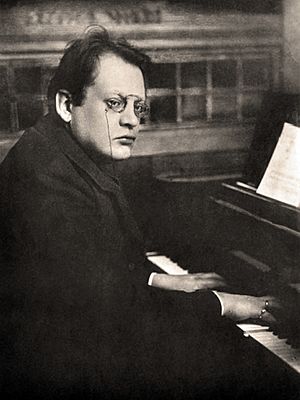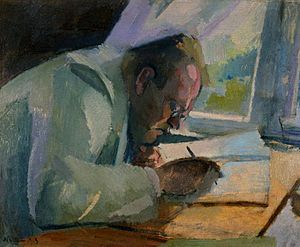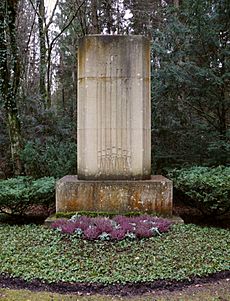Max Reger facts for kids
Quick facts for kids
Max Reger
|
|
|---|---|

Reger at the piano, c. 1910;
by Rudolf Dührkoop |
|
| Born |
Johann Baptist Joseph Maximilian Reger
19 March 1873 Brand, Kingdom of Bavaria, German Empire
|
| Died | 11 May 1916 (aged 43) |
| Resting place | Munich Waldfriedhof, Kingdom of Bavaria, German Empire |
| Education |
|
| Occupation |
|
| Organization |
|
|
Works
|
List of compositions |
| Spouse(s) | Elsa Reger |
| Signature | |
 |
|
Max Reger (born Johann Baptist Joseph Maximilian Reger; March 19, 1873 – May 11, 1916) was a famous German composer, pianist, organist, and conductor. He was also a teacher. Reger worked as a concert pianist, a music director at the Leipzig University Church, and a professor at the Royal Conservatory in Leipzig. He also served as a music director for Duke Georg II of Saxe-Meiningen.
At first, Reger mostly wrote songs (called Lieder), chamber music (for small groups of instruments), choral music (for choirs), and pieces for piano and organ. Later, he started composing for orchestras. Some of his well-known orchestral works include the Variations and Fugue on a Theme by Mozart (1914). He also wrote large pieces for choir and orchestra, like Gesang der Verklärten (1903) and Der 100. Psalm (1909).
Contents
Max Reger's Early Life
Max Reger was born in Brand, a town in Bavaria, Germany. He was the first child of Josef Reger, who was a school teacher and loved music. His mother was Katharina Philomena. His family was very religious and Catholic. They moved to Weiden in 1874. Max had one sister, Emma.
When Max was five, he started learning music. His father taught him to play the organ, violin, and cello. His mother taught him the piano. From 1884 to 1889, Max took more piano and organ lessons from Adalbert Lindner, who was one of his father's students. During this time, Max often played the organ at the local church when Lindner was not available. In 1886, his parents wanted him to become a teacher, so he went to the Royal Preparatory School.
Discovering a Passion for Music
In 1888, Max's uncle, Johann Baptist Ulrich, invited him to the Bayreuth Festival. There, Max heard operas by Richard Wagner, like Die Meistersinger von Nürnberg and Parsifal. This experience deeply impressed him. It made Max decide that he wanted to be a musician.
Soon after, Max wrote his first big piece, the Overture in B minor. It was a long orchestral work. Lindner sent the music to Hugo Riemann, a music expert. Riemann liked it but told Max to focus on writing melodies. Max finished preparatory school in 1889. That same year, he wrote more pieces, including a string quartet. His father asked him to send these works to composer Josef Rheinberger, a professor in Munich. Rheinberger saw Max's great talent. Despite his father's worries, Max chose to follow a career in music.
Starting His Music Studies
In 1890, Reger began studying music theory with Hugo Riemann in Sondershausen. Later, he studied piano and theory in Wiesbaden. His first published works were for chamber music and songs. Since he was a concert pianist himself, he also wrote many pieces for piano and organ. His first work for choir and piano was Drei Chöre (1892).
In 1898, Reger returned home to Weiden because he was ill. While there, he wrote his first piece for choir and orchestra, called Hymne an den Gesang (Hymn to Singing). In 1899, he started trying to win the heart of Elsa von Bercken, who at first said no. He wrote many songs for her, including Sechs Lieder, Op. 35.
In September 1901, Reger moved to Munich. There, he started getting many concert offers and became famous quickly. In his first year in Munich, he performed in ten concerts as an organist, pianist, and accompanist. He earned enough money from publishers, concerts, and teaching to get married in 1902. Because his wife Elsa had been divorced and was a Protestant, he was removed from the Catholic Church. He kept composing, creating works like Gesang der Verklärten, Op. 71.
Reger's Career and Later Life
In 1907, Reger became the music director at the Leipzig University Church. He also became a professor at the Royal Conservatory in Leipzig. He held the church position until 1908.
In 1908, he started writing Der 100. Psalm (The 100th Psalm), Op. 106. This piece for choir and orchestra was for the 350th anniversary of Jena University. He finished it in 1909, and it was first performed in 1910.
In 1911, Reger became the music director (Hofkapellmeister) for Duke Georg II of Saxe-Meiningen. He also managed the music at the Meiningen Court Theatre. He continued to teach his master class at the Leipzig conservatory. In 1913, he composed four pieces based on paintings by Arnold Böcklin. One of these was Die Toteninsel (Isle of the Dead), Op. 128.
In 1914, Reger left his court position due to health problems. When World War I started, he planned to write a choral work to remember those lost in the war. He began setting the Latin Requiem but did not finish it. He composed eight motets (short choral pieces) called Acht geistliche Gesänge für gemischten Chor (Eight Sacred Songs, Op. 138). These pieces showed a new, simpler style.
In 1915, he moved to Jena. He traveled to Leipzig once a week to teach. In Jena, he composed the Hebbel Requiem for a soloist, choir, and orchestra. He dedicated this piece to the soldiers of World War I.
Max Reger died from a heart attack on May 11, 1916, while staying at a hotel in Leipzig. The final copies of his Acht geistliche Gesänge were found next to his bed. Six years after he died, his ashes were moved from his home in Jena to a cemetery in Weimar. In 1930, his wife Elsa wanted his remains moved again. They were placed in a special grave of honor in Munich Waldfriedhof.
Reger also traveled internationally as a conductor and pianist. Some of his students became famous musicians, including Joseph Haas and George Szell. He was also the cousin of Hans von Koessler.
Max Reger's Music
Max Reger created a huge amount of music in just over 25 years. His works were very well known in Germany during his lifetime. Many of his pieces use fugues or variation form. An example is the Variations and Fugue on a Theme by Mozart, which is based on a theme from Mozart's Piano Sonata in A major, K. 331.
Organ Music
Reger wrote a lot of music for the organ. His most popular organ piece is the Benedictus from his collection Op. 59. Another famous one is his Fantasy and Fugue on BACH, Op. 46. While studying, Reger met the German organist Karl Straube. They became good friends and colleagues in 1898. Straube performed many of Reger's organ works for the first time.
Reger even recorded some of his own works on the Welte Philharmonic organ in 1913. He also composed various other organ pieces, like the Introduction, Passacaglia and Fugue, Op. 127. This piece was dedicated to Straube, who first performed it in 1913.
Style and Influences
Reger loved the fugue form and wrote music in almost every style, except for opera and the full symphony. He did compose a Sinfonietta, Op. 90. He believed in "absolute music," which means music that is not about a story or picture. He saw himself as following in the footsteps of great composers like Beethoven and Brahms.
Reger's music often combined the classical structures of Beethoven and Brahms with the rich harmonies of Liszt and Wagner. He also added the complex counterpoint (multiple melodies played together) of Bach. Reger's organ music was also influenced by Liszt and the organ traditions of his time.
Some of his works for solo string instruments are often heard in recordings. His piano music shows him as a successor to Brahms in German music. He continued Brahms's ideas of developing musical themes and changing keys freely. His music was also rooted in Bach's polyphony (many independent melodies).
Vocal Works
Reger wrote many vocal works. These include songs, pieces for mixed choirs, men's choirs, and women's choirs. He also wrote larger choral works with orchestras, such as Der 100. Psalm and the Requiem. The Requiem used a poem by Friedrich Hebbel and was dedicated to soldiers of World War I. He wrote music for poems by many different poets. Reger himself gave official "opus numbers" to his major works.
His music can be seen as looking back to older styles. He used classical and baroque techniques like fugue and continuo (a type of bass line). The influence of continuo can be heard in his chamber works, which are thoughtful and unique.
Films About Max Reger
Several films have been made about Max Reger's life and music.
Documentaries
- The documentary Max Reger – Music as a perpetual state was released in 2002. It was directed by Andreas Pichler and Ewald Kontschieder. This was the first film to show facts about Max Reger's life. It was made with help from the Max-Reger-Institute.
- Max Reger: The Last Giant is another documentary film. It tells the story of Reger's life and works. This film is part of a 6-DVD set called Maximum Reger, released in December 2016. This set marked 100 years since Reger's death. The set includes parts of Reger's most important works for orchestra, piano, chamber groups, and organ.
See also
 In Spanish: Max Reger para niños
In Spanish: Max Reger para niños




